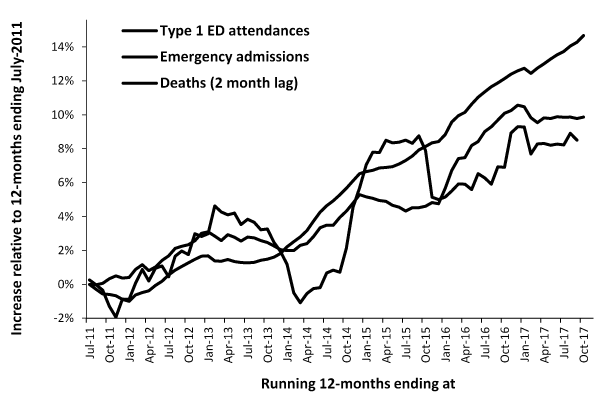In this edition of FGNAMB I have presented two studies investigating highly unusual and complex non-linear trends in deaths in England [1,2]. Although not yet established, it would not be surprising to find that fractal geometry in the transmission of a pathogen between members of social networks were involved in these unique trends.
We must ask, why are deaths so important? One study has shown that 42% of admissions and 55% of hospital bed days occur in the last year of life [3]. Hence marginal changes in the number of deaths are sufficient to make considerable changes in the marginal number of admissions and occupied beds.

Figure 1. A rolling (moving/running) 12-month total of type 1 emergency department attendances, emergency admissions (all acute specialties including paediatrics), and deaths for the whole of England.
Figure 1 shows a rolling (moving/running) 12-month total of type 1 emergency department attendances, emergency admissions (all acute specialties including paediatrics), and deaths for the whole of England. Each line is a composite picture across many thousands of social networks involving different ages, hence in order of increasing average age: type 1 ED attendances < emergency admissions < deaths. In addition, the line for deaths has been shifted to the left by two months due to a somewhat logical gap between illness and eventual death. Despite differences in age profiles the three lines show undulations which roughly commence at the same time. The table-top feature in the line for deaths starting in January 2015 is the result of a large spike in deaths in that month. In a rolling total this spike moves through the 12-month total and exits the total after 12 months. This spike seems to have little effect on ED attendances, but may have led to a modest change in the slope of the emergency admissions line. As has been pointed out the exact trends at sub-national geographies depend greatly on location, gender and local social group composition [1,2].
However, it needs to be pointed out that forecasts of deaths made over the past decade by the Office for National Statistics all agree that deaths should be nowhere near the levels observed after 2014 [4]. In addition, periods of unexplained higher deaths and medical admissions have occurred in the past but have seemingly never been investigated [5].
When deaths and medical admissions are investigated at sub-local authority small-area level the trend seems to be characterized by on/off switching [6-8]. Such behaviour was hitherto considered to be not possible, and hence no one had thought to look for such behaviour.
Urgent research is needed around the world to confirm this behaviour, and to identify the causative agent.
- Jones R (2017) Role of social group and gender in outbreaks of a novel agent leading to increased deaths, with insights into higher international deaths in 2015. FGNAMB 3.
- Jones R (2017) Different patterns of male and female deaths in 2015 in English and Welsh local authorities question the role of austerity as the primary force behind higher deaths. FGNAMB 3.
- Hanlon P, Walsh D, Whyte B, Scott S, Lightbody P, et al. (1998) Hospital use by and ageing cohort: an investigation into the association between biological, behavioural and social risk markers and subsequent hospital utilization. J Public Health Med 20: 467-476. [Crossref]
- Jones R (2017) What government data on death rates fail to show. Brit J Healthcare Manage 23: 572-573.
- Jones R (2017) Periods of unexplained higher deaths and medical admissions have occurred previously – but were apparently ignored, misinterpreted or not investigated. Eur J Internal Medicine 50: e18-e20. [Crossref]
- Jones R (2017) Outbreaks of a presumed infectious pathogen creating on/off switching in deaths. SDRP Journal of Infectious Diseases Treatment and Therapy 1: 1-6.
- Jones R (2015) Small area spread and step-like changes in emergency medical admissions in response to an apparently new type of infectious event. FGNAMB 1: 42-54.
- Jones R (2015) Infectious-like spread of an agent leading to increased medical hospital admission in the North-East Essex area of the East of England. FGNAMB 1: 98-111.
Editorial Information
Editor-in-Chief
Bianciardi Giorgio
University of Siena
Article Type
Editorial
Publication history
Received date: March 05, 2017
Accepted date: March 15, 2017
Published date: March 22, 2017
Copyright
© 2017 Jones RP. This is an open-access article distributed under the terms of the Creative Commons Attribution License, which permits unrestricted use, distribution, and reproduction in any medium, provided the original author and source are credited.
Citation
Jones RP (2017) Death and medical admissions – what is happening in the UK?. Fractal Geometry and Nonlinear Anal in Med and Biol 1: DOI: 10.15761/FGNAMB.1000143
Corresponding author
Rodney P Jones
Healthcare Analysis and Forecasting, Leominster, UK
E-mail : bhuvaneswari.bibleraaj@uhsm.nhs.uk

